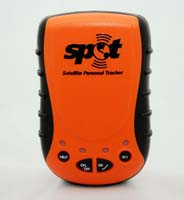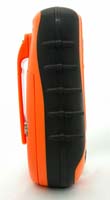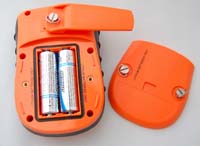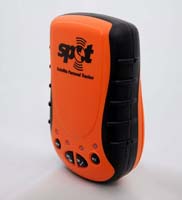 ™
™TRADITIONAL MOUNTAINEERING
™
www.TraditionalMountaineering.org
™ and also
www.AlpineMountaineering.org
™
 ™
™
FREE BASIC TO ADVANCED
ALPINE MOUNTAIN CLIMBING INSTRUCTION™
Home
| Information
| Photos
| Calendar
| News
| Seminars
| Experiences
| Questions
| Updates
| Books
| Conditions
| Links
| Search
![]()
![]() Search this site!
Search this site!
Read more:
SPOT-2 Reviewed and recommended
SPOT Satellite Messenger "PLB" reviewed and recommended
News Flash! SPOT v.2.0 came on sale for about
$149.00 in stores in September 2009! Read More below, but read this page first!
I watched a television commercial just before Christmas 2007, and I wrote down www.findmespot.com. I ran for the computer! I was very impressed by the quality of the Spot, Inc. website, the images of the device and the credentials of the listed executives. SPOT is owned by Globalstar, Inc. the world wide satellite telephone company which owns a constellation of private communications satellites. I was also impressed by the clarity and simplicity of the instructions for using the SPOT Satellite Messenger. However, there is one critical exception to the original user instructions. Read on, carefully! Be sure to see the end of this page: SPOT must be used correctly; How to Test the SPOT and the Basic improvement of SPOT over PLBs
At first I was attracted by the reasonable price of $169.00 for a seven ounce "Personal Locator Beacon". Then I realized that this device is NOT YOUR MOTHER'S "PLB". This "Satellite Messenger" is based on messages sent through the world wide privately owned Globalstar, Inc. Satellite Phone System and not based on the old PLB COSPAS-SARSAT search and rescue system!
Also, the SPOT Satellite Messenger (listing at $169.00, but available most everywhere at $150.00! and sometimes on sale for $99.00) uses an internal GPS (global positioning system) receiver not found in PLBs costing under $650.00. GPS latitude-longitude coordinates are found by the instrument through conventional contact with the worldwide constellation of US Defense Department satellites, just like your trusty Garmin eTrex H. Then, the SPOT sends the "GPS location" (Latitude and Longitude coordinates) and your selected message "I am exactly here and having fun"; "I am exactly here and need help from my friends"; or, "I am exactly here and I have called 911 for official rescue services!" The email or text cell phone messages are sent to up to ten people each.
PLBs and EPIRBS:
A major drawback of traditional PLB's for me, is that they can not
be "tested" before use. The device just sits there in your pack, like an expensive
twelve ounce brick until you need to call 911 for official rescue services. Read More about the
traditional PLB Personal Locator Beacon. PLBs for aircraft and personal use
were developed from the marine EPIRBs; EPIRBS have
been responsible for more than 5,752 individual rescues up to December 2005. The
PLB technology was not legal for use in land based applications until July 1,
2003 and I have been unable to find data on PLB rescues. (SPOT claims over 50
rescues in the first 18 months of introductory use.)
For years, we purchased expensive big orange marine EPIRB devices for our "yachts". They could not be tested but at least made a nice statement about our "off shore" capabilities just hanging at the hatch. The smaller class B EPIRBs that broadcast at 121.5 MHz based on older technology may take hours to provide the Coast Guard with a location and may not be monitored today by commercial shipping according to a report in the February 2008 issue of Sea Kayaker Magazine. This technology is being phased out. EPIRBs and PLBs may not come equipped with an internal GPS receiver and may not provide accurate Latitude and Longitude coordinates.
The SPOT is a new technology. It is not a "PLB".
Read on!
Be sure to see the end of this page: SPOT must be used
correctly; How to Test the SPOT and the Basic improvement of SPOT over PLBs
The SPOT Satellite Messenger has three
(satellite telephone technology generated) messages for your Responsible Person:
1. I am exactly here RP and friends and I am OK; 2.
I am exactly here RP and friends and I could use
a little help right now; and 3. I am exactly here RP and friends, 911
has been called and I need
real Rescue Services.
My friend Jim Witty, outdoors reporter for our Central Oregon regional daily, The Bulletin, called in December 2007, to ask what I thought about this new device. I said "I think it is terrific" It's a huge thing!" He quoted my exclamation in his news story.
Jim had purchased two with his brother and they drove out to the backcountry to test the device. Jim used message 1. and shortly received a call on his brothers cell phone giving his Latitude and Longitude coordinates and an "I am OK" message.
They raced home to find an email message to their Responsible Person: "I'm OK", with a Google map showing their coordinates.
Jim Witty scooped Central Oregon with a huge spread on the front page of the Wednesday January 2, 2008 Community Life section of The Bulletin. Further, he used my cogent quote: "Don't wait for your Responsible Person to call 911 when you fail to return at 5 p.m. on Sunday" said Speik, "Reserve the option to call for assistance when you break your leg on Friday, using your ordinary digital cell phone and/or your new Spot locator beacon."
My friend Cpl. Neil Mackey of the Deschutes County Sherriff's Search and Rescue Unit told me that SAR had recently tested the Spot Satellite Messenger in the field, using Message 3: "911, I need Rescue" and they found that it worked well.
REI sells the product for $149.00. This device was so new, that Associates at the store in Bend before Christmas were not familiar with the SPOT and were very interested when I explained to them that it was an important breakthrough: Satellite communication to a Responsible Person's cell phone and their email account and, if needed, to 911 Rescue Services by messages with GPS coordinates.
Note that the SPOT Satellite Messenger requires a $99.99 annual satellite telephone service subscription. You can sign up on the web. You can actually list up to ten recipients for each of the three messages. Peter Kummerfeldt, well known Outdoors Instructor based in Colorado, suggests you leave your mother off the 911 list. Peter says he has tested the Spot many times and confirms that it works. Peter gave a talk at the Central Oregon Sportsman's Show, which featured the Spot.
Satellite communications are provided by Globalstar, Inc., (NASDAQ:GSAT). Globalstar has established a private satellite telephone communications network. (According to news reports, the two way telephone capability of their satellites is being degraded by radiation and the two way part of their Globalstar satellite system will have to be replaced. This radiation degradation does not affect the Spot according to Donnie Hatch, Spot Distribution Manager, Western United States, since only one-way communication is required by Spot.)
911 Emergency Services are Powered by GEOS
Alliance.
"GEOS offers a wide variety of services that encompass security, safety and
reliable communications for corporations as well as domestic and international
travelers. The GEOS program is delivered through a fusion of state-of-the-art
technology with the unparalleled experience of the very best and most respected
specialists in the fields of international, personal and corporate protection
and communications. This special 24-7 world wide service costs only $7.50 per
year and I chose this optional service. To learn more about GEOS and the full range of services
offered worldwide, visit http://www.geosalliance.com
Required Cost of the Service
"The basic $99.99 satellite service
subscription for SPOT includes:
!. CHECK IN:
Let up to ten contacts know where you are and that you’re okay. Unlimited usage included.
2. ASK FOR HELP:
Request help from up to ten friends and family at your exact location. Unlimited usage
included.
3. ALERT 911:
Dispatch emergency responders to your exact location and notify up to ten
friends and family. Unlimited usage included."
A $49.00 Geos option allows you the interesting unlimited ability to track your progress periodically on Google Earth with messages to your Responsible Persons). Adventure Racers like this feature.
There is also a $7.50 optional GEOS "Search & Rescue
Benefit":
"For $7.50/year USD (if purchased at initial activation. $150.00 USD
afterwards) you are provided up to $100,000 USD of additional search and rescue resources, including
helicopter extraction around the world and reimbursement benefits – underwritten
by Lloyd’s of London – for any emergency service expenses incurred. For more
information, including terms and conditions, visit
http://www.geosalliance.com/sar
This option may not be necessary in the United States due to our
sophisticated 911 emergency service and Sherriff's volunteer Search and Rescue
teams. However, in other parts of the world, rescue of American citizens may be
organized by the nearest Embassy.
Company Background
"The SPOT Satellite Messenger, the world's first satellite messenger, uses
both the GPS satellite network to determine a customer's location and the SPOT
network to transmit that information to friends, family or an emergency service
center. SPOT Inc., a subsidiary of Globalstar, Inc., (NASDAQ:GSAT) provides
lifesaving communications technology that allows users to communicate from
remote locations around the globe. Thanks to this affordable, cutting-edge
personal safety device, the company offers people unmatched peace of mind by
allowing customers to notify friends and family of their location and status,
and to send for emergency assistance in time of need, completely independent of
cellular phone or wireless coverage. For more information on how SPOT, Inc. is
helping users live to tell about it™ – from disaster preparedness to outdoor
adventure purposes – explore this web site."
--On Belay! Robert Speik
Copyright© 2007-2010 by Robert Speik. All Rights Reserved.




Warning: the spot must be used correctly!
SPOT Satellite Messenger Update
April 2008
Note from Robert Speik:
Recently, three testers on
BackPackGearTest.org questioned the ability of SPOT to connect
to the GPS satellites and to the Communications satellites.
In each case, the three field testers clipped
their SPOT to belt or pack-strap:
"I wore the spot on my pack's sternum strap because there weren't any better
options for securely mounting the device on the pack anywhere else."
"The belt clip which is held in place by one of the flathead screws had begun to
loosen itself over time allowing the belt clip to be sloppy and not stay
securely in place. I think this might have attributed to the Spot coming off of
my shoulder strap at Gold Creek."
"As I hiked the Spot was clipped to my belt on the front of my pants."
Photos by "Coasty" show the SPOT propped upright
next to a rock, virtually eliminating contact with the satellites.
Copyright© 2008 - 2010 by Robert Speik. All Rights Reserved.
http://www.backpackgeartest.org/reviews/Communication_Gear/SPOT Satellite Messenger/
How to use the spot correctly!
Perhaps it is not obvious on the SPOT website
or in the booklet packed with the device, but SPOT MUST BE LYING ON ITS BACK
WITH THE LABEL UP IN ORDER TO HAVE MAXIMUM CONTACT WITH THE GPS SATELLITES AND
THE COMMUNICATIONS SATELLITES. People standing around the unit or placing it
next to a boulder may also block
the line of site electronic signal.
Garmin GPS receivers, on the other hand, must be standing up straight with the the users hand at the
lower part of the unit and no people hovering over and around it in order to see what is
going on.
To re-state it, SPOT is best at connecting with the GPS satellites and to the Communications satellites when it is comfortable lying on its back with the label up. The antenna needs to see the entire sky and not just half or less off to one side. This is kind of explained in the booklet packed with the unit. I have checked this information with SPOT Customer Service and I have heard this explained by a SPOT distributor. Clip the SPOT to the top of your Saloman "Raid Race" summer Day pack of take a rest and give it a chance to get comfortable on its back on a rock.
My wife and I are Federally licensed General Class Ham Radio Operators and we have studied the way "antennas" work. They are directional, and that is why the GPS and the SPOT must be oriented correctly. This is not a design fault. I agree with some that the SPOT User Guide should be more clear. I agree that the nice big belt clip should be removed by the operator. Place the SPOT in the top pocket of your day pack (yes, on top of the extra hat, gloves and ClifBars). Or turn it on when you stop for lunch, camp or a 15 minute break. Note that PLBs must actually deploy an antenna and that it must be pointed at the sky and many models require factory service to charge the battery.
Bloggers on NWHikers.net are concerned because
of this connect ability question. I will bet their SPOTS were clipped on belt or
pack and not HAPPY.
One described how he got a good contact when he laid
the SPOT (flat) on the hood of his car. One described how the unit was oriented:
. . ."keep spot upright and make sure it's free
from obstruction . . . Another referenced the tests
from BackPackGearTest.org. that we have noted were not oriented correctly.
Personally, I am a happy well oriented user.
Copyright© 2008 - 2010 by Robert Speik. All Rights Reserved.
http://www.nwhikers.net/forums/viewtopic.php?p=334009#334009
How to "test" the SPOT
Here is what I mean about "testing" the SPOT:
Again, an improvement of SPOT over traditional PLBs which were recently
authorized for land use in July 2003, is it's ability to real-life
"test" the communication signals where the user hikes, hunts, sleds, skis, climbs and
wanders. If the user programmed message "Hello, I am exactly here and I am having Fun" message gets
through, so will the "I am exactly here and 911 Rescue Services are on the way, but don't worry Honey".
The traditional PLB can be tested for sending
out a signal. It cannot be tested for whether the signal has actually been received
by 911.
Copyright© 2008 - 2010 by Robert Speik. All Rights Reserved.
The basic improvement of SPOT over land PLBs
Again, an improvement of SPOT over PLBs is the ability to "real-life test" the communication system where the user actually hikes, hunts, sleds, climbs and wanders. If the user programmed message "Hello, I am exactly here and I am having fun" gets through, so will the message "911 Rescue Services are on the way, but don't worry Honey".
The traditional PLB can be tested for sending out a signal. It cannot be tested for whether the signal has actually been received.
DISCLAIMER: I AM NOT AN ENGINEER OR TESTER. THESE ARE
SIMPLY MY EDUCATED THOUGHTFUL OPINIONS!
Copyright© 2008 - 2010 by Robert Speik. All Rights Reserved.
SPOT-2 REVIEWED AND RECOMMENDED
![]()
![]()
![]()
![]() WARNING - *DISCLAIMER!*
WARNING - *DISCLAIMER!*
Mountain climbing has inherent dangers that can, only in part, be mitigated
Read more . . .
OpEd: Yuppie 911 devices can take the search out of Search and Rescue
![]()
SPOT Unveils Next Generation Satellite GPS Messenger at Outdoor Retailer
![]()
Gear grist, an article written for The Mountaineer, the monthly magazine of The Mountaineers
Robert Speik writes: "There is no denying the sense of cell" for the
magazine of The Mountaineers
Snowboarder lost overnight near Mount Bachelor, rescued by SAR
![]()
Lithium batteries recommended for GPS backcountry use
Lessons learned from the latest lost Mt. Hood climbers
SPOT Satellite Messenger "PLB" reviewed and recommended
How do digital mobile phones assist mountaineering and backcountry rescues?
Clinic on Real Survival Strategies and Staying Found with
Map, Compass and GPS together
What do you carry in your winter day and summit pack?
Why is the digital cell phone best for backcountry and mountaineering?
What is a PLB or Personal Locator Beacon?
Why are "Snow Caves" dangerous?
Why are "Space Blankets" dangerous?
Why are "Emergency Kits" dangerous?
How can you avoid Hypothermia?
Missing climbers on Mount Hood, one dies of exposure, two believed killed in fall
Missing California family found, dad dies from exposure and hypothermia
Missing man survives two weeks trapped in snow-covered car
Missing snowmobile riders found, Roger Rouse dies from hypothermia
Olympic Champion Rulon Gardner lost on snowmobile!
Lost Olympic hockey player looses feet to cold injury
Expert skier lost five days near resort in North Cascades
without map, compass, gps or cell phone
Mount Hood - The Episcopal School Tragedy
Mount Hood - experienced climbers rescued from snow cave
How can you learn the skills of snow camping?
Prospectus
Lost and Found
Three climbers missing on Mt. Hood, all perish
Missing California family found, dad dies from exposure and hypothermia
Missing man survives two weeks trapped in snow-covered car
Missing snowmobile riders found, Roger Rouse dies from hypothermia
Longacre Expeditions teen group rescued from the snowdrifts above Todd Lake
Lost climber hikes 6.5 miles from South Sister Trail to Elk Lake
Hiking couple lost three nights in San Jacinto Wilderness find abandoned gear
Expert skier lost five days in North Cascades without Essentials, map and compass
Climber disappears on the steep snow slopes of Mount McLaughlin
Hiker lost five days in freezing weather on Mount Hood
Professor and son elude search and rescue volunteers
Found person becomes lost and eludes rescuers for five days
Teens, lost on South Sister, use cell phone with Search and Rescue
Lost man walks 27 miles to the highway from Elk Lake Oregon
Snowboarder Found After Week in Wilderness
Searchers rescue hiker at Smith Rock, find lost climbers on North Sister
Girl Found In Lane County After Lost On Hiking Trip
Search and rescue finds young girls lost from family group
Portland athlete lost on Mt. Hood
Rescues after the recent snows
Novice couple lost in the woods
Broken Top remains confirmed as missing climber
Ollalie Trail - OSU Trip - Lost, No Map, Inadequate Clothing
Your Essential Light Day Pack
What are the new Ten Essential Systems?
What does experience tell us about Light and Fast climbing?
What is the best traditional alpine mountaineering summit pack?
What is Light and Fast alpine climbing?
What do you carry in your day pack?
Photos?
![]()
What do you carry in your winter day pack?
Photos?
![]()
What should I know about "space blankets"?
Where can I get a personal and a group first aid kit?
Photos?
Carboration and Hydration
Is running the Western States 100 part of "traditional mountaineering"?
What's wrong with GORP?
Answers to the quiz!
Why do I need to count carbohydrate calories?
What should I know about having a big freeze-dried dinner?
What about carbo-ration and fluid replacement during traditional alpine climbing?
4 pages in pdf
![]()
What should I eat before a day of alpine climbing?
About Alpine Mountaineering:
The Sport of Alpine Mountaineering
Climbing Together
Following the Leader
The Mountaineers' Rope
Basic Responsibilities
![]() Cuatro Responsabiliades Basicas de Quienes Salen al Campo
Cuatro Responsabiliades Basicas de Quienes Salen al Campo
The Ten Essentials
![]() Los Diez Sistemas Esenciales
Los Diez Sistemas Esenciales
Our Leader's Guidelines:
Our Volunteer Leader Guidelines
Sign-in Agreements, Waivers and Prospectus
This pdf form will need to be signed by you at the trail head
Sample Prospectus
Make sure every leader tells you what the group is going to do; print a copy for your "responsible person"
Participant Information Form
This pdf form can be printed and mailed or handed to the Leader if requested or required
Emergency and Incident Report Form
Copy and print this form. Carry two copies with your Essentials
![]()
Participant and Group First Aid Kit
Print this form. Make up your own first aid essentials (kits)
![]()
About our World Wide Website:
Information
Mission
![]()
Map, Compass and GPS
Map, compass and GPS navigation training Noodle in The Badlands
BLM guidelines for Geocaching on public lands
Geocaching on Federal Forest Lands
OpEd - Geocaching should not be banned in the Badlands
Winter hiking in The Badlands WSA just east of Bend
Searching for the perfect gift
Geocaching: What's the cache?
Geocaching into the Canyon of the Deschutes
Can you catch the geocache?
Z21 covers Geocaching
Tour The Badlands with ONDA
The art of not getting lost
Geocaching: the thrill of the hunt!
GPS in the news
A GPS and other outdoor gadgets make prized gifts
Wanna play? Maps show you the way
Cooking the "navigation noodle"